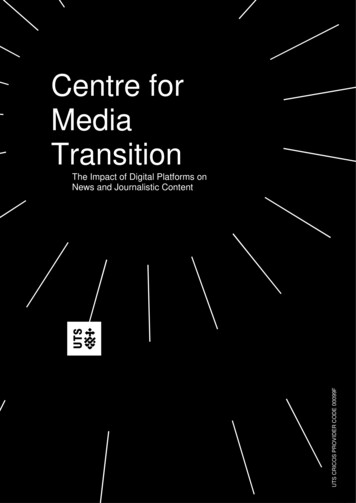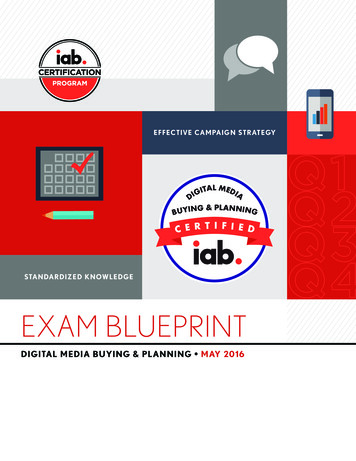
Transcription
Centre forMediaTransitionUTS CRICOS PROVIDER CODE 00099F175PROVIDERUTS CRICOSCODECODE 00099FPROVIDERTS CRICOS0099FThe Impact of Digital Platforms onNews and Journalistic Content
Centre for Media TransitionThe Centre for Media Transition is an interdisciplinary research centre established jointly by theFaculty of Law and the Faculty of Arts and Social Sciences at UTS.We investigate key areas of media evolution and transition, including: journalism and industrybest practice; new business models; and regulatory adaptation. We work with industry, publicand private institutions to explore the ongoing movements and pressures wrought by disruption.Emphasising the impact and promise of new technologies, we aim to understand how digitaltransition can be harnessed to develop local media and to enhance the role of journalism indemocratic, civil society.The principal researchers on this report were Derek Wilding, Peter Fray, Sacha Molitorisz andElaine McKewon. The following researchers also contributed to the work for the report:Gabriel Yakub, Chrisanthi Giotis, Nik Dawson, Divya Murthy, Charlotte Grieve, Mai Duong.Rosa Alice provided administration and project management support.Suggested citation:Wilding, D., Fray, P., Molitorisz, S. & McKewon, E. 2018, The Impact of Digital Platforms onNews and Journalistic Content, University of Technology Sydney, NSW. Copyright Centre for Media Transition 2018UTS CRICOS PROVIDER CODE: 00099FContactCentre for Media TransitionBuilding 5, Block B, Level 4, Room 32UTS City Campus, HaymarketGPO Box 123, Broadway NSW 2007CMT@uts.edu.au2
ForewordThis report was commissioned by the Australian Competition and ConsumerCommission (ACCC) as an input to the Digital Platforms Inquiry.The Centre was asked by the ACCC to research and report on aspects relating to newsand journalistic content, one of several matters under the Terms of Reference for theinquiry issued by the Treasurer in December 2017.Specifically the Centre was asked to describe and analyse the impacts of digitalplatforms on choice and quality for Australian news consumers. The brief for the projectrecognised that plurality, diversity, choice and quality in the contemporary mediaenvironment are highly complex and contested issues, and the inquiry would benefitfrom an analytical framework through which these issues could be considered.The research addresses four broad themes of relevance to the inquiry, all of whichrelate specifically to news and journalistic content: The characteristics of this content and its public function in democratic society Choice, including production and distribution as well as diversity Consumption, including access and specific practices such as customisation Quality, including any changes in quality in the contemporary environment.We were asked to review relevant academic literature and other available resources,and specifically to consider any approaches to measurement of aspects such asdiversity and quality that might assist in assessing the current environment. We werenot asked for recommendations on regulatory intervention.The project is comprised entirely of desk-top research, accessing local andinternational materials. These include academic texts and journal articles, policyreports, industry data and other available material. The project methodology excludedinterviews and any other empirical research, as the Commission had itself embarkedon an extensive consultation program.The arrangement of the material in the report reflects our progression from the generalcharacteristics of news and journalistic content, through the international thinking onthe impact of technology, approaches to quality, and finally plurality.This work is our own and should not be taken as representing the views of the ACCC.Derek Wilding and Peter FrayCo-Directors, Centre for Media Transition, October 20183
Executive SummaryA report on the impact of digital platforms on choice and quality for Australiannews consumersChapter One. A contested landscape Australians are consuming more news more often, preferring onlineaccess over offline. Digital platforms have changed the news. The consumption,distribution and production of news have altered fundamentally. Theplatforms provide a point of access to news – a function formerlyperformed by media companies. Journalism has multiple roles: it monitors and curbs power; itsupports and creates public debate; and it educates and entertains. News is a public good — it serves a purpose beyond the immediateneeds of advertisers and consumers — but it is difficult to monetisethat ‘good’. Hence, it has traditionally needed a cross subsidy in theform of advertising or, in some cases, government support. To attract audiences, news producers often have to make theircontent available to search engines and social media with little or nofinancial return. And to satisfy the workings of digital platforms,news producers create content that is more emotive and shareable.Chapter Two. The impacts of technology Technology does not determine consumer behaviour; but itinfluences and shapes online behaviour by enabling andencouraging consumers to engage in certain ways, not in others. In many cases, algorithms determine which content newsconsumers get to see. The workings of these algorithms are nottransparent. The evidence on filter bubbles and echo chambers, and on theirimpacts, is inconclusive. Collaborations could be encouraged between digital platforms andnews media to develop and refine technology that serves bothparties’ interests, as well as the interests of consumers and citizens.4
Chapter Three. Quality in news and journalistic content Driven by a shared professional identity and journalistic values, thenews industry has maintained a range of accountability instrumentsincluding industry codes of ethics and journalistic norms andpractices. The contemporary media environment has introduced newchallenges to maintaining journalistic quality: the 24/7 news cycle;algorithms; the blogosphere. For news consumers, this represents anew information asymmetry. In response to escalating quality challenges, a number of onlinecommunities have assumed the roles of news media ‘watchdog’,‘fact-checker’ and ‘critic’. Indicators of journalistic quality can be grouped under three sets ofcriteria: content indicators; organisational indicators; and audienceengagement indicators. The current regulatory framework for the news media is fragmented.There are ways in which digital platforms, as participants within thebroader social framework for news media, could help maintainjournalism’s accountability schemes.Chapter Four. Choice and diversity ‘Choice’ in competition law has a close parallel in media regulationwhere ‘availability’ is a measure of media diversity; as a frameworkfor assessing the digital media environment, media diversity canaccount for the public functions of journalism. Media regulation in Australia takes a narrow approach to diversity,based on availability of traditional media, while omitting all onlinenews, pay TV and public media. While Australian regulation only considers the supply aspect ofavailability, measurement systems used in the EU and the UK alsotake account of consumption and impact; this offers a richer pictureof choice. Internationally there is no consensus on the most suitable term forregulation, but the more targeted concept of ‘media plurality’ used inthe UK is likely to be more suitable for application in Australia thanthe expansive concept of ‘media pluralism’ used in the EU. Even these recent attempts at measuring plurality or pluralism haveonly limited success in accounting for the impact of algorithmicdelivery of news and the use of recommenders; this is now thefocus of international research on diversity and pluralism.5
Conclusion There is conflicting evidence on the overall impact of digitalplatforms on news and journalistic content. It appears some negative effects – such as shorter, more emotivecontent – can be attributed to platforms; others – like pressures ofthe 24/7 news cycle – are largely an aspect of digitisation. Two aspects present specific future risks: sudden algorithmicchanges which can severely disrupt conditions under which news isproduced; and the potential devaluation of journalism throughextractive summaries. Digital platforms can now be regarded as key participants within thebroader framework for news media; they may not be publishers, buttheir role as distributors is increasingly hybrid in nature. As participants within this news media framework, digital platformshave a responsibility not to harm the public benefit provided bynews and journalistic content; there may also be ways to promote it.6
ContentsForeword3Executive Summary4Contents7Introduction91 A contested landscape11The certainty of uncertainty12The hybrid role of platforms12Definitions and functions15DefinitionsPublic benefits of journalismIs news found or made?Impact of digitisation15182123Production, consumption and citizenshipToday’s news consumerMaking it payCitizens and/or consumersFake news and atomisation2424273031Fake newsEngagement as practiceThe atomisation of news313437The values of journalism39Bourdieu and BuzzfeedA clash of valuesConclusion2 The impacts of technology39414346The role of technology in shaping behaviour47The impact of algorithms49Personalisation and customisation51PersonalisationCustomisationFilter bubbles and echo chambersReduced diversity of newsCompromised autonomy and constrained choiceTransparency and accountabilityArtificial Intelligence (AI)Automated journalismAutomatic Text SummarisationAI bias51565758616263646567Further innovation and ‘affordances’68Search Engine Optimisation (SEO)First Click Free and Flexible Sampling68697
Instant Articles and Accelerated Mobile PagesConclusion70713 Quality in news and journalistic content73Quality in the contemporary media landscape74Professional standards and regulationThe digital challengeInnovations in journalismApproaches to assessing qualityOrganisational quality indicatorsAudience engagement quality indicatorsContent quality indicatorsQuality and regulation in AustraliaFragmentation: Fourteen separate codes of practiceRulemaking, complaints and enforcementRegulatory frameworkCode rulesComplaintsUpholding complaints about qualityConclusion4 Choice and diversity74757678808183878788889093949698The Australian regulatory environment99Overview of the regulatory environmentSector-specific rulesMedia ownership rulesAssessing diversity within this framework99100101103The meaning of diversity, plurality and pluralismMultiple meanings‘Pluralism’ in the EU and ‘plurality’ in the UKWhich term is most suitable for Australia?104105107108Measurement110EU: The Media Pluralism Monitor111How the MPM worksUK: The Ofcom frameworkElements of the Measurement FrameworkThe place of platformsInfluence of algorithms of public affairsThe role of ownership and controlSuitability of these schemes for AustraliaApplying the Ofcom metricsAccounting for platformsAdditional commentsSummary and observations on the role of ion147Bibliography1528
IntroductionThis report arrives at a fractious time in journalism. There is a paradox: at the sametime as audiences face a world awash with content and information, the professionbest skilled and most dedicated to help them make sense of the deluge — a craftsteeped in notions of truth-seeking and serving the public interest — finds itself underintense pressure and attack on several fronts. These challenges are numerous andgrowing: unprecedented loss of revenue; technological disruption on a grand scale; thehamster-wheel impulses of the 24/7 news cycle; questions about journalism’s qualityand authority. There is an uneasy sense that something once permanent andunassailable is now up for grabs. These issues are addressed in numerous guises inthis report. But for now, we wish to collapse them down to one word: influence.A host of social, political, economic and technological actors have combined to chipaway at — and raise urgent debate about — the influence and role of journalism.In understanding this, we need to recognise the opaque and changing elements in howjournalism works, how news comes into being, how news organisations operate andsee themselves and their audiences. But there is no hiding the outputs of those effortsand practices. By contrast, digital platforms are much younger. Their role and place arestill becoming clear. There is a fluidity as to how they think about journalism — andhow in turn, journalism and those who seek to protect it, should think about them.As The Economist (2018, p. 51) recently noted, seeking to achieve a particularoutcome for content, such as a balanced news feed, may well present a ‘definitionalquagmire’. But that is not to give the digital platforms a free pass. How their practicesand protocols impinge on what journalism does in the present — and might wish to doin the future — is worthy of prolonged scrutiny.In the following chapters we take on key elements of that challenging task. In ChapterOne, we look at what journalism is, what it does and how, in a world where traditionalmodels of revenue, content creation and reporter-audience relations are changing. InChapter Two, we consider a key determinant in those changes: technology. Inparticular, we look at what impact the digital service platforms owned by the technologycompanies are having on production, distribution and consumption patterns — and theflow-on effect those factors are having on the content and diversity of news. We payparticular attention to the impact of social media, search and content aggregators andthe dominance of Facebook, Twitter and Google as primary distributors of newscontent. This role, akin to being the news ‘broker’ between journalism and its multipleaudiences, drives our thinking when we tackle the complex questions that surrounddiversity and plurality in Chapter Four. Before we do so, in Chapter Three, we look atthe vexed and multi-dimensional question of quality in journalism – how is it bestunderstood and, as with the rest of this report, which parts are changing and which, ifany, are immovable.9
This report is best described as a framework. In both the chapters on quality andplurality we offer some guidance as to how literal frameworks are used to consider theoverarching concerns of the ACCC’s Digital Platforms Inquiry.There is little doubt that the platforms will have an ongoing and profound impact on thesupply of news and journalistic content. Much of this will be unambiguous. There is, forinstance, no denying that Facebook and Google glean the lion’s share of digitaladvertising revenues. That is what they have been created to do and they have provedextremely effective at doing so. But much more ambiguous is the way in which thedigital news agenda is being set by news companies, digital platforms and increasingly,the participatory public. This debate may, as we suggest above, still be in its infancy.Advertisers — and other funders of journalism — should be added to that loose troika.Advertisers were once locked into a model that rewarded scarcity and promised captiveaudiences. We now live in age of abundance — of attention and content seeking tomonetise that attention. Some industry observers have characterised this as ‘peakcontent’: there is simply insufficient revenue around to support the amount of contentbeing produced (Anderson 2016). It doesn’t necessarily follow that we have reachedpeak journalism. There is a high degree of ambiguity abroad in society and journalismis no exception. But we argue that journalism remains a special case. We hope ourefforts may help clear away some of the ambiguity surrounding its multiple roles andrelationships and point to where deeper dialogue and consideration of new ideas maycreate equitable and sustainable outcomes.We started this introduction noting some of the immediate challenges and threats facedby the news media industry. As a potential offset, there is considerable, well-placedand positive sentiment towards the industry, in particular its role in providing publicinterest journalism. This inquiry is evidence of that: six years on from the FinkelsteinInquiry, prompted by the illegal activities of some journalists in another country, we nowhave another inquiry which seeks to examine the potential threats to journalism.Much of the current debate has tapped into a hard vein of thought within the industrythat what ails journalism is not journalism but those who feed off it. There may be alarge dollop of truth and even bigger scoop of sentiment in such thinking. But is itwhere journalism needs to be to survive this fractious time? As this report shows,journalism and digital platforms are inextricably linked in the provision of news andcontent. The ties that bind them are now deeply set in the behaviours of their sharedaudiences.10
1 A contested landscape Australians are consuming more news more often, preferring onlineaccess over offline. Digital platforms have changed the news. Consumption, distributionand production have altered fundamentally. For news producers, thepre-digital business model has crumbled. Journalism has multiple roles: it monitors and curbs power; itsupports and creates public debate; and it educates and entertains. News is a public good — it serves a purpose beyond the immediateneeds of advertisers and consumers — but it is difficult to monetisethat ‘good’. Hence, it has traditionally needed a cross subsidy in theform of advertising or, in some cases, government support. To attract audiences, news producers make their content availableto search engines and social media with little or no financial return.And to satisfy the workings of digital platforms, news producerscreate content that is more emotive and shareable.In 1920, reporter and commentator Walter Lippmann argued for a public recognition ofthe dignity of a career in journalism, arguing that ‘the health of society depends uponthe quality of the information it receives’ (1920, p. 48). For Lippmann, the provision ofnews did more than just inform people, it served to better humanity: ‘The chief purposeof the “news” is to enable mankind to live successfully toward the future’ (p. 52). Thesegrand sentiments have proved highly influential.In response, however, detractors have argued that in practice journalism has regularlyfailed to meet such high hopes and ideals. Radio presenters accept cash for comment;reporters trample on the right to privacy; bias is rampant. Recently, these argumentshave grown louder. Over the past 50 years, public trust in journalism and news mediahas collapsed. While the theoretical value of journalism and news media remainswidely acknowledged, its practice is increasingly challenged.In the digital platform era, journalism and news media have come under intensescrutiny. With the advent of digital platforms – including Google in 1998, Facebook in2004 and Twitter in 2006 – questions about the role and value of the news loom large.What’s more, digital platforms have changed the news. The consumption, distributionand production of news have altered fundamentally: where once news producers alsotended to be its distributors, now consumers and digital platforms have also taken onthe role of distributors. In this way and many others, the relationship between news andits audience has become more complicated and layered, with far-reaching impacts forconsumers and producers of news, and also for digital platforms.11
In this chapter, we address the nature and characteristics of news and journalisticcontent in a contemporary media environment. Specifically, we investigate: the socialand community impacts attributable to the production, distribution and consumption ofnews and journalistic content, which include supporting an informed citizenry andeffective democracy; the ‘public good’ characteristics of media content and services;and the extent to which digital platforms have amplified or diminished the benefits ofnews media, and altered the underlying economic characteristics of news content. Inother words, we will explore the role and value of journalism and news media in thecontext of digital platforms.As the research shows, the impacts of digital platforms on news are profound andunprecedented, presenting momentous opportunities and challenges.The certainty of uncertaintyFor today’s producers, distributors and consumers of news, uncertainty is a given,disruption is the norm and change is a constant. The result is a confusion of effects: onthe one hand, benefits and opportunities; on the other, harms and challenges.The benefits of recent changes are many. Digital platforms give news producersaccess to substantial audiences, while search engines and social media engage globalaudiences at unprecedented speed. This explains the success of internet news outletssuch as Upworthy, Buzzfeed and Vox, which mastered the art of creating viral content(Foer 2017, p. 139).1 As a result, news consumers have access to an unprecedentedarray of content. Indeed, consumers can now become producers, as seen by theemergence of terms such as ‘prosumer’ and ‘produser’ (Aitamurto 2011, Bruns 2007).On digital platforms, the voiceless can express themselves and audiences can becomeempowered as citizens and creators.The harms are significant too, however. For news producers, the pre-digital businessmodel has crumbled. Between 2011 and 2015, Australian newspaper and magazinepublishers lost 1.5 billion and 349 million respectively in print advertising revenue,while gaining only 54 million and 44 million in digital (as noted by this inquiry’s IssuesPaper). By 2016, three quarters of the total Australian online advertising spend went toGoogle and Facebook. And since the US presidential election of 2016, the issue offake news – and the ongoing dismissal by some public figures of unsympatheticcoverage as ‘fake news’ – continues to challenge the credibility of journalism and newsmedia (Marwick 2018; see below).The hybrid role of platformsOne of the biggest and most complex changes involves the ways in which therelationship between journalists and audience is shifting.1However, Upworthy is hardly an unqualified success story: in August 2018, it laid off 31 staff (Baldridge 2018). Seealso ‘Engagement as practice’, below.12
Admittedly, the transaction between journalists and the public has never been entirelystraightforward. Most commonly, the practice of journalism was funded by the sale ofadvertising, in a happy accident that regularly saw profit and the public interest coincidefor news producers. In economic terms: traditional news media operated in a two-sidedmarket with its audience and advertisers, where democratic exchange was a significantpositive externality. In the era of digital platforms, however, that two-sided market hasbecome a multi-sided market (see below, ‘The economics of journalism’). Digitalplatforms have entered the frame, to tremendous effect.In this way, the relationship between journalists and audience has become morecrowded. This in itself is significant, because the relationship between news media andits public is crucial. As journalism scholar James Carey wrote in 1987, ‘the public’ is the‘god term of journalism’:Insofar as journalism is grounded, it is grounded in the public. Insofar asjournalism has a client, the client is the public. The press justifies itself in thename of the public: it exists – or so it is regularly said – to inform the public, toserve as the extended eyes and ears of the public, to protect the public’s right toknow, to serve the public (Carey 1987, p. 5).As noted above, one key aspect of the change in the journalist/audience relationship isin the way digital platforms have helped consuming audiences to become creatingaudiences (Meikle & Young 2012, p. 108). As Axel Bruns writes: ‘The very idea ofcontent production may need to be challenged: the description of a new hybrid form ofsimultaneous production and usage, or produsage, may provide a more workablemodel’ (Bruns 2007, p. 99). The new model has been described as ‘we media’ (Willis &Bowman 2003). Here, traditional journalism has been superseded by ‘participatoryjournalism’ (Lasica 2003; Singer et al. 2011, p. 2). Participatory journalism comprisescitizen journalism, naturally, but also comments sections, discussion forums and theexpanding universe of blogs, Twitter, 4chan and Reddit. In 2018, particularly thanks tosocial media, consumers are no longer passive; instead, they filter and discuss thecontent of the news, and help to create it.2As a result, the only way to understand the news media today is to take account of thisdynamic, interactive environment. Bruns argues that our efforts to understand the:multifaceted and dynamic news environment within which we now operate willcontinue to be restricted if we continue to apply categorical distinctions betweenindustrial news production and individual news consumption, betweenprofessional and citizen journalism, between private and public engagement(Bruns 2018, p. 370).Thanks to digital platforms, the relationship between news producers and newsconsumers has become more fluid, and more interactive.2There is a caveat: not all consumers take advantage of the interactive possibilities of digital platforms. As we detailbelow, news consumption for some people is predominantly passive. They let the news come to them, often in the formof ‘incidental news exposure’ on social media. See ‘Today’s news consumer’.13
In other ways, the relationship between journalists and audience has become lesscrowded. Sometimes journalists have been taken out of the picture altogether. Thishappens, for instance, when those involved in the news bypass the news media and gostraight to their audience. On July 12, 2018, the Thai Navy posted a five-minute videoto Facebook called ‘The operation the world never forgets’. It showed divers cleaningmasks and checking gear, preparing to rescue 12 boys and their soccer coach, whohad become trapped in the Tham Luang caves in northern Thailand. Instead of issuingpress releases and offering spokespersons for interviews with television, radio andnewspaper outlets, the Thai Navy published its footage straight to Facebook. Within aweek, the video had been viewed 2.5 million times, had attracted 150,000 likes (and35,000 other reactions) and been shared 44,000 times. Traditional news outletsincluding Channel Nine News and The Sydney Morning Herald (among many others)then drew on the Thai Navy’s post in their own coverage (Prytz 2018).In many ways, digital platforms have become an access point, fulfilling a functionformerly performed by media companies. Indeed, one emerging impact of digitalplatforms is that the role of news producer is often separated out from the role of newsdistributor. In many cases, news producers make the news while digital platformsdistribute it, as we detail below. This enables digital platforms such as Facebook andGoogle to sell advertising generated on the back of diverse content, including newscontent produced off site.For Robin Foster, there are four ways in which intermediaries work as gatekeepers,including control of distribution bottlenecks, but also what he describes as their‘editorial-like judgements’ about news content (2014, p. 29). Yet this control is hardlyunchecked. Traditional media also retain powerful gatekeeping and agenda-settingroles. With the continuing power of ‘gatekeeping trust’, news organisations retainsignificant power over news selection and agenda setting, which creates: a shared dominance of digital agendas by a relatively small number ofinstitutional megaphones, be they platform monopolies, aggregators, or majorconventional news organizations (Schlosberg 2018, pp. 209, 213-14).Digital platforms do not typically produce news content. They do, however, play a keyrole in news distribution. They also shape the news agenda. As such, they are lessthan content producers, but more than mere intermediaries. They perform a hybrid rolethat involves, to some degree, both distribution and deciding what is and isn’tacceptable content. This is particularly evident with social media. As Tarleton Gillespiewrites:As soon as Facebook changed from delivering a reverse chronological list ofmaterials that users posted on their walls to curating an algorithmically selectedsubset of those posts in order to generate a News Feed, it moved fromdelivering information to producing a media commodity out of it. If that is aprofitable move for Facebook, terrific, but its administrators must weigh thatagainst the idea that the shift makes them more accountable, more liable, forthe content they assemble — even though it is entirely composed out of the14
content of others (Gillespie 2018b, p. 33; we return to this argument in ChapterFour).The digital news agenda is now controlled both by news companies and the digitalplatforms that play a significant role in news distribution. And, increasingly, theparticipatory public helps set the agenda too. In this multi-sided market, news mediatransact with audiences, advertisers and digital platforms. Disentangling this four-sidedrelationship, let alone its impacts, is challenging.To proceed, it helps to define and discuss some key terms: ‘media’, ‘digital platforms’,‘news’ and ‘journalism’.Definitions and functionsDefinitionsDigital platformsIn this report, we are concerned with the impacts of ‘digital platforms’ and ‘platformservices’: digital search engines, social media platforms and content aggregators, aswell as hybrids thereof. We are specifically concerned with the impact of digitalplatforms on news media and its consumers.‘Media’ stems from the Latin, ‘medium’, or middle (Chun, Fisher & Keenan 2006, p. 2).Traditionally, the news media’s role has been as mediator: to stand i
6 Conclusion There is conflicting evidence on the overall impact of digital platforms on news and journalistic content. It appears some negative effects – such as shorter, more emotive content – can be attributed to platforms; others – like pressures of the











